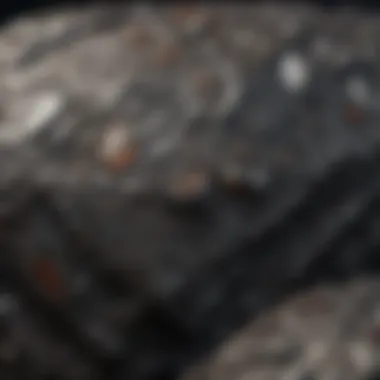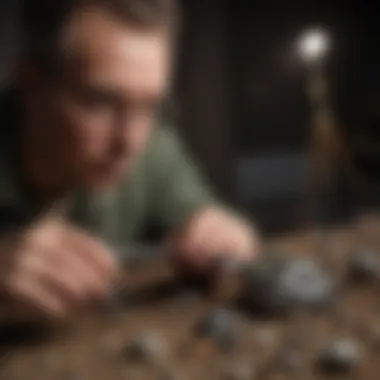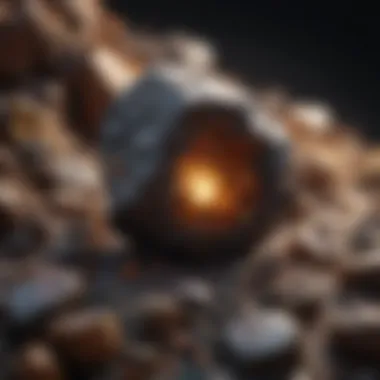Identifying Genuine Meteorites: A Comprehensive Guide


Intro
Identifying meteorites can be a specific yet thrilling pursuit. The earliest humans looked to the skies, wondering about the origins and nature of celestial objects. Some meteorites, which are remnants of larger bodies from outer space, have fallen to Earth over millennia. They tell stories of the solar system's history. For collectors, the challenge lies in discerning genuine meteorites from terrestrial rocks that may resemble them.
This guide aims to provide thorough insights into the world of meteorites. Understanding the characteristics and features essential for genuine identification is critical. The differences between meteorites and similar-look alike stones can be subtle. Therefore, this article not only wishes to educate but also seeks to dispel prevalent myths surrounding meteorites.
Preamble to Meteorites
Meteorites are a fascinating subject of study, captivating collectors, scientists, and enthusiasts alike. Understanding meteorites allows one to appreciate not just their beauty, but also their historical significance and scientific value. This section will outline the fundamental ideas surrounding meteorites.
The importance of defining meteorites goes beyond mere classification. It sets the stage for their identification and understanding their origins. Meteorites are remnants of the early solar system, offering insights into planetary formation and the conditions present in space. They come in various types, and each type reveals different characteristics. Recognizing these differences can help identify authentic meteorites and avoid common misconceptions.
Definition of Meteorites
A meteorite is defined as a solid fragment of material that survives its passage through Earth's atmosphere and lands on the surface. This definition may seem straightforward, but it encompasses various scientific and geological aspects. A clear understanding of this definition is the first step in identifying genuine meteorites.
Types of Meteorites
Meteorites can be broadly categorized into several types. Knowing these categories aids in identifying specific samples and understanding their properties. The main types of meteorites include:
- Chondrites
- Achondrites
- Iron Meteorites
- Stony-Iron Meteorites
Chondrites
Chondrites are the most abundant type of meteorite. They are characterized by the presence of small, round particles called chondrules. These particles formed early in the solar system’s history, making chondrites crucial for studying the formation of planets. Their composition typically consists of silicate minerals and metal, indicating their diverse origins. Their abundance in collecting and research makes them a beneficial choice for those interested in meteorites. Furthermore, the study of chondrites can provide valuable information about the conditions in the solar nebula, offering insights into early solar system materials.
Achondrites
Achondrites differ from chondrites by lacking chondrules. They often originate from larger bodies, like asteroids or planets, and have undergone differentiation, meaning their materials have settled into layers based on density. This gives achondrites a unique appeal for collectors, as they often showcase various minerals. They are valuable in understanding how celestial bodies evolve. However, due to their rarity compared to chondrites, they can be a challenge to source and identify.
Iron Meteorites
Iron meteorites are primarily composed of metal, mainly iron, and nickel. They are striking due to their metallic appearance and can be identified by their heavy weight. Their unique structure, such as Widmanstätten patterns, distinguishes them from terrestrial metals. They are popular among collectors because of their aesthetic and physical properties. However, due to their durability, they are less informative about the early solar system compared to other types, as they do not deliver much information about the mineral content.
Stony-Iron Meteorites
Stony-Iron meteorites represent a complex category, containing both metallic and stony components. This duality makes them an intriguing subject of study. They form in the cores of differentiated parent bodies, combining both types of meteorites. Their uniqueness can enhance a collection significantly, making them desirable for enthusiasts. However, their limited availability may pose difficulties in procurement.
Understanding these types establishes a foundation for identifying genuine meteorites effectively. Each category holds significance in planetary sciences and adds depth to a collector’s experiences.
Physical Characteristics to Examine
Understanding the physical characteristics of meteorites is crucial. These features provide essential clues to their authenticity. Several aspects, such as weight, density, surface texture, and magnetic properties, help differentiate genuine meteorites from terrestrial rocks. Collectors should pay attention to these characteristics because they offer tangible indicators of a meteorite's origin in space. Examining these physical traits can enhance the identification process tremendously, saving time and resources while increasing confidence in the findings.
Weight and Density
Weight plays a significant role in identifying meteorites. Most meteorites are denser than typical Earth rocks; hence, they usually feel heavier for their size. For instance, a small meteorite can weigh considerably more than a similar-sized basalt rock. Density can be measured by taking the weight of the specimen and dividing it by the volume it displaces when submerged in water.
- Density Values:
- Chondrites typically range between 3.0 to 3.5 g/cm³.
- Iron meteorites generally exceed 7.0 g/cm³.


If the weight seems unusually high, it's worth examining closer. This method provides a practical approach to identifying potential meteorites, enabling collectors to quickly assess a find.
Surface Texture
The surface texture of a meteorite can reveal much about its origin. True meteorites often exhibit a distinctive blend of textures. Common features to look for include:
- Fusion Crust: This is a thin, glassy layer formed when the meteorite enters the Earth's atmosphere. It appears smooth and dark.
- Regmaglypts: These are thumbprint-like depressions on the surface, formed due to heating.
Observing the condition of the surface can also indicate its exposure time on Earth. Fresh meteorites tend to display more defined characteristics than weathered specimens, aiding in identification. Hence, thorough inspection of these textures can provide critical insights into recognizing authenticity.
Magnetic Properties
Most meteorites possess unique magnetic properties due to their iron content. One of the easiest ways to test a specimen is with a simple magnet. Genuine meteorites, particularly iron and stony-iron types, will often attract magnets. Some key points include:
- Iron Meteorites: These are usually highly magnetic due to their metallic composition.
- Stony Meteorites: These may show little to no magnetic attraction, but can still exhibit weak magnetic properties due to small amounts of iron minerals.
It is important to note that not all magnetic rocks are meteorites. Thus, this test should not be the only identifier. However, it can significantly narrow down the possibilities.
For further reading on meteorites, resources can be found at Encyclopedia Britannica and Wikipedia.
The Role of Composition
When identifying genuine meteorites, understanding the composition is essential. Composition refers to the specific minerals and elements that make up a meteorite. This fundamental aspect can provide vital clues about its origin, age, and classification. Distinguishing meteoritic materials from terrestrial counterparts is critical for collectors and researchers. Different compositions often indicate different types of meteorites, which helps in narrowing down identifications.
Analyzing the composition can reveal not only structural differences but also enhancements in the methods used for validation. It is important to note that the mineral content can vary greatly between meteorite types, including chondrites, achondrites, and iron meteorites. Each type has unique characteristics linked to its elemental makeup. For collectors, accurate identification can significantly enhance their collections by ensuring they acquire authentic specimens that match their intended criteria.
Mineral Content Analysis
Mineral content analysis is a process that involves determining the types and proportions of minerals present within a specimen. In meteorites, the most common minerals include olivine, pyroxene, and feldspar. Each mineral offers insight into the conditions under which the meteorite formed.
For instance, chondrites, the most prevalent type of meteorite, typically contain small, round grains known as chondrules, composed mainly of silicate minerals. These structures inform us about the early solar system and how bodies formed in it.
Methods of mineral analysis can include:
- Thin Section Analysis: Cutting a slice of the meteorite and examining it under a polarizing microscope.
- X-Ray Diffraction: Identifies crystalline materials, helping to determine mineral types.
- Electron Microprobe: Provides detailed compositions of specific minerals within the sample.
Choosing the right analysis method will depend on the desired level of detail. Overall, a thorough mineral analysis bolsters the reliability of identification claims and enhances scientific understanding.
Isotopic Ratios
Isotopic analysis involves measuring the ratios of isotopes within a meteorite. Elements such as oxygen, carbon, and nitrogen exhibit different isotopes, which can be crucial for identifying a meteorite's origin. The isotopic signature of a meteorite can also tell us about its history, including any alterations that have occurred during its journey through space and entry into Earth's atmosphere.
For example, the ratio of oxygen isotopes can differ vastly between Earth and extraterrestrial materials, making it easier to differentiate between them.
Common techniques for isotopic analysis include:
- Mass Spectrometry: Measures the abundance of isotopes, providing precise elemental ratios.
- Stable Isotope Analysis: Focuses on isotopes that do not decay over time, offering stable readings for comparison.
Utilizing isotopic ratios adds another layer of verification in identifying meteorites. It enhances the collector’s knowledge about the provenance of the specimen in question, ultimately contributing to a more informed collection and deeper appreciation for these celestial objects.
Common Myths About Meteorites
Understanding common myths surrounding meteorites is essential for anyone interested in rock and fossil collection. Myths can lead to misconceptions, potentially altering one's perspective on what constitutes a genuine meteorite. This section will clarify these myths, aiming to empower collectors with knowledge. By debunking these notions, we shed light on authentic identification methods.


Myth: All Unusual Rocks are Meteorites
One prevalent myth is that all unusual rocks found on Earth are meteorites. This idea stems from excitement about the extraterrestrial, alongside a lack of familiarity with geological processes. In reality, the Earth is home to an astounding variety of rock types, many of which can appear peculiar or out of the ordinary.
Unusual appearances can arise from various terrestrial processes, such as weathering, erosion, or even man-made activities. For instance, certain basalts can feature striking patterns, resembling meteorites at first glance.
To accurately assess whether a rock is a meteorite, consider the following characteristics:
- Magnetic properties: Many meteorites exhibit magnetic traits that distinguish them from terrestrial rocks.
- Density and weight: Meteorites generally have a higher density than common rocks.
- Surface features: Unique features like regmaglypts or a fusion crust can indicate a meteorite's authenticity.
Ultimately, it is vital not to assume that all unusual rocks are meteorites. Serious identification requires thorough examination and often professional analysis.
Myth: Meteorites are Always Hot
Another widespread myth is the belief that meteorites are always hot upon landing. This idea can be misleading. When meteoroids travel through the atmosphere and become meteors, they experience intense friction, generating heat. However, this heat dissipates quickly once the object comes to rest on the surface.
Upon landing, the temperature of a meteorite can indeed be close to the ambient temperature, rendering this myth erroneous. Many meteorites are not perceptibly warm and may feel cool to the touch.
To summarize, when examining a meteorite, do not rely on temperature as a sole indicator of authenticity. Instead, focus on:
- Magnetic response: As stated, many meteorites will respond to magnets.
- Specific gravity: Use a scale or water to measure density accurately.
- Professional validation: Seeking assistance from experts can provide accurate evaluation.
By debunking these myths, rock and fossil collectors can improve their chances of correctly identifying genuine meteorites. It is imperative to rely on proven methods and scientific evidence rather than assumptions.
Verification Techniques
Verification techniques are crucial when it comes to identifying genuine meteorites. They serve to validate the authenticity of materials that are often mistaken for terrestrial rocks. Employing sound verification techniques enhances the reliability of meteorite identification. This section examines both professional testing options and field testing methods that can be effectively used.
Professional Testing Options
Professional testing options are essential for collectors and enthusiasts pursuing certainty about their specimens. Laboratories specializing in meteoritics provide advanced analytical methods to examine the material's properties. Using techniques like scanning electron microscopy (SEM) and X-ray fluorescence (XRF), these facilities can obtain detailed compositional data. This data reveals the elemental and mineral makeup, which are fundamental in distinguishing meteorites from Earth rocks.
Collecting samples for professional tests requires careful handling. It is advisable to preserve the specimen in its original condition as much as possible, avoiding any alterations. Clients can send small pieces of their finds to reputable institutions for a thorough analysis. Examples of such institutions include the Smithsonian Institution's National Museum of Natural History and specialized laboratories found in university geology departments.
Costs for professional testing can vary. However, consider this as an investment in valuable information. Knowing the identity and characteristics of a specimen can greatly enhance its worth to collectors.
Field Testing Methods
Field testing methods provide a more accessible way for collectors to assess their specimens without needing professional laboratory equipment. While less precise than professional testing, these methods can offer initial insights into the authenticity of a meteorite.
- Magnetic Testing: Since many meteorites contain metallic iron, the initial step involves checking a specimen for magnetic properties. A simple magnet can give guidance. However, some Earth rocks may also show magnetism, so this should be one of multiple techniques.
- Visual Identification: Observing the physical characteristics of the rock can yield information. Look for regmaglypts—small indentations on the surface. These are unique features typically only found on meteorites.
- Streak Test: This involves rubbing the specimen against a piece of unglazed porcelain. A meteorite will often leave a distinct trail or streak. In contrast, other rocks may not show such clarity.
- Weight and Density Check: Meteorites usually have higher density compared to terrestrial rocks. Weighing the sample and calculating its density can yield additional evidence regarding its authenticity.
Using these field testing methods, collectors can obtain a preliminary assessment of their specimens. It is crucial, however, to follow up with professional testing for definitive conclusions. The combination of field methods and lab analysis creates a comprehensive approach to verification.
Investing time in both field tests and professional assessments is essential for discerning true meteorites from ordinary stones.
Resources for Meteorite Identification
Understanding the methods for identifying genuine meteorites is crucial for collectors and enthusiasts alike. Resources for meteorite identification can significantly enhance one’s knowledge and skills. This section explores various materials and communities that provide invaluable information and support.
Guidebooks and Manuals
Guidebooks and manuals serve as crucial references for individuals seeking to identify meteorites accurately. These publications often combine illustrations, photographs, and detailed descriptions to foster a clearer understanding of meteorite characteristics. They can cover diverse topics, including how to differentiate meteorites from terrestrial rocks and the salient features of distinct meteorite classes.


Some recommended guidebooks include:
- The Meteorite Handbook: This book provides an excellent overview of types, characteristics, and identification methods for meteorites.
- Field Guide to Meteorites: Not only does this guide provide identification tips, but it also includes information about where to find meteorites in nature.
Investing in quality guidebooks enhances one's ability to quickly reference key features and properties. Moreover, possessing updated information is essential as new research emerges frequently in the field of meteoritics.
Online Communities and Forums
The digital age offers remarkable opportunities to connect with fellow meteorite enthusiasts. Online communities and forums serve as vibrant platforms where individuals can share insights, ask questions, and receive feedback on their findings. Such interaction is invaluable since it facilitates learning from others’ experiences and knowledge.
Platforms such as Reddit and Facebook have dedicated groups for meteorite collectors. For example, the subreddit r/Meteorites provides a space for asking questions and sharing images for identification. Members often include both amateurs and experts, ensuring a wealth of knowledge is available.
Additionally, these online resources allow for the exchange of identification photos, where individuals can present their specimens for community feedback. As such, they enable enthusiasts to overcome some of the challenges that exist in remote areas where access to physical resources may be limited.
In summary, utilizing guidebooks and online forums greatly enhances the capability to identify genuine meteorites. By leveraging both structured literature and community interaction, collectors can refine their skills, ensuring a more accurate and informed approach to meteorite identification.
Recognizing Authentic Meteorites
Understanding how to recognize authentic meteorites is crucial for anyone interested in the field. This knowledge not only distinguishes valuable finds from common terrestrial stones but also enhances the experience of collecting and studying these fascinating objects from space. Meteorites provide insights into the history of our solar system and the formation of planetary bodies. Therefore, the ability to identify real specimens is integral to both scientific inquiry and personal collections.
Evident Features of Real Meteorites
When attempting to identify genuine meteorites, certain features stand out. One primary characteristic is the exterior surface, which often exhibits a fusion crust. This crust is a thin, glassy layer formed as the meteorite passes through the Earth's atmosphere at high speeds. The texture of this crust can be smooth or slightly pitted, depending on the meteorite's journey.
Another notable feature is the presence of regmaglypts. These are thumbprint-like impressions found on the surface of some meteorites, indicating the effects of intense atmospheric heating and melting during their descent.
Moreover, most meteorites uniquely possess a metallic or mineral composition. Each type of meteorite has distinct minerals or metals that can be observed under a microscope or in hand samples. Recognizing these characteristics helps in distinguishing meteorites from terrestrial rocks.
Differentiating from Similar Terrestrial Rocks
It is also essential to differentiate genuine meteorites from similar terrestrial rocks. Familiarity with common rock types helps collectors and enthusiasts make informed assessments.
Basalts
Basalts are volcanic rocks that can resemble some meteorites due to their dense texture and dark color. A significant characteristic of basalt is its uniform structure, which can mislead those unfamiliar with meteorites. However, basalt lacks the metallic characteristics and fusion crust found on meteorites. Its formation process, mainly through volcanic activity on Earth, also differentiates it from the extraterrestrial origins of meteorites.
Sedimentary Rocks
Sedimentary rocks are another category that can be misidentified. These rocks often show layers and are usually softer compared to meteorites. A key feature of sedimentary rocks is their composition, which can include fossils and organic materials, making them distinct from meteorites' mineral makeup. When identifying, note the absence of a fusion crust in sedimentary rocks.
Volcanic Rocks
Volcanic rocks share some similarities with meteorites but differ significantly in features. Volcanic rocks like pumice and obsidian may exhibit a glassy appearance and a similar density but lack the necessary fusion crust and unique internal structure. They are formed through Earth processes, contrasting the formation conditions of meteoric materials.
Recognizing the distinct features and properties of meteorites sets apart genuine specimens from terrestrial rocks, enhancing both the collector's experience and the scientific understanding of space materials.
Finale
In summarizing the guide on identifying genuine meteorites, it becomes evident that understanding and recognizing these celestial objects is of paramount importance for both collectors and enthusiasts alike. Meteoritics offers a window into the universe's history, so being able to differentiate real meteorites from terrestrial rock formations allows one not only to appreciate the beauty and uniqueness of these extraterrestrial specimens but also to contribute to the scientific discourse surrounding them.
Summary of Key Points
The journey to authentic meteorite identification involves several critical elements:
- Physical Characteristics: Analyzing weight, density, surface texture, and magnetic properties are fundamental steps to distinguish meteorites from ordinary rocks.
- Composition Analysis: Delving into the mineral content and isotopic ratios provides insights into the rock's origin and authenticity. This level of detail can pinpoint specific types of meteorites, further enhancing their collectability and scientific value.
- Debunking Myths: Awareness of common misconceptions about meteorites, such as the belief that all unusual rocks are meteorites, helps refine one’s identification skills and fosters a more informed approach to collecting.
- Verification Techniques: Utilizing both professional testing options and field methods allows individuals to authenticate their finds accurately, ensuring they are part of credible collections.
- Resources and Communities: Engaging with guidebooks, manuals, and online forums can enrich one’s knowledge base and connect with other enthusiasts and experts in the field.
"> By remaining informed and vigilant, collectors can ensure that their collections consist not only of beautiful stones but of scientifically significant specimens."
The comprehensive steps outlined in this guide emphasize the need for careful examination and verification. In an age where the fascination with meteorites continues to grow, having the ability to discern genuine specimens from imitations solidifies one’s role in the ongoing exploration of our solar system.



